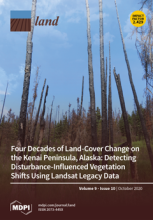/ library resources
Showing items 1 through 9 of 131.A framework was developed to elucidate (1) the drivers of land degradation, (2) pressures, (3) local impacts and vulnerabilities and (4) adaptation strategies.
With growing global demand for food, unsustainable farming practices and large greenhouse gas emissions, farming systems need to sequester more carbon than they emit, while also increasing productivity and food production.
Amid climate change, biodiversity loss and food insecurity, there is the growing need to draw synergies between micro-scale environmental processes and practices, and macro-level ecosystem dynamics to facilitate conservation decision-making.
Insects, the most diverse and abundant animal species on the planet, are critical in providing numerous ecosystem services which are significant to the United Nation’s Sustainable Development Goals (UN-SDGs).
Street trees, native plantings, bioswales, and other forms of green infrastructure alleviate urban air and water pollution, diminish flooding vulnerability, support pollinators, and provide other benefits critical to human well-being.
Through an exploratory case study conducted in the Pesio Valley, northwest Italy, this paper proposes a framework for maintaining traditional chestnut production landscapes and addressing future development policies.
In an era of global warming, long-standing challenges for rural populations, including land inequality, poverty and food insecurity, risk being exacerbated by the effects of climate change.
The amount of habitat in a landscape is an important metric for evaluating the effects of land cover on biodiversity, yet it fails to capture complex temporal dimensions of resource availability that could be consequential for species population dynamics.
Green infrastructure is a strategically planned network of natural and semi-natural areas, including green and blue spaces and other ecosystems, designed and managed to deliver a wide range of ecosystem services at various scales.
Pagination
Land Library Search
Through our robust search engine, you can search for any item of the over 73,000 highly curated resources in the Land Library.
If you would like to find an overview of what is possible, feel free to peruse the Search Guide.



